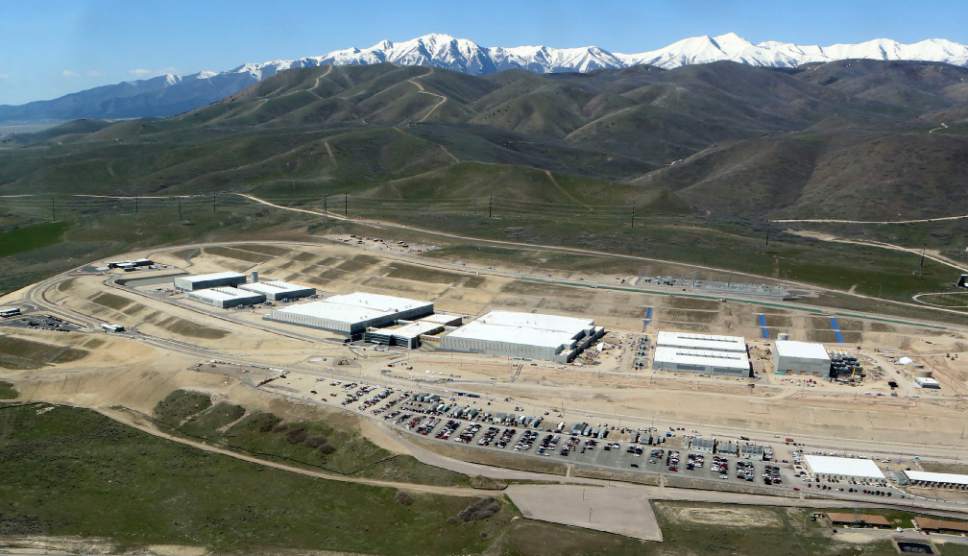This is an archived article that was published on sltrib.com in 2017, and information in the article may be outdated. It is provided only for personal research purposes and may not be reprinted.
The National Security Agency conducted "blanket" warrantless surveillance of Salt Lake-area residents during the 2002 Olympic Winter Games, according to a former agency senior executive.
The declaration by Thomas A. Drake contradicts one given earlier this year by the former director of the NSA, Michael Hayden, that said neither the President's Surveillance Program (PSP), nor any other NSA intelligence-gathering activity, was involved in indiscriminate and wholesale surveillance in Salt Lake City or other Olympic venues during the 2002 Winter Games.
Drake's declaration is part of a lawsuit filed in 2015 in U.S. District Court for Utah that claims violations of privacy over an alleged dragnet warrantless government surveillance program that included meta-data as well as emails and text messages.
"I have reviewed the declaration of Michael V. Hayden dated March 8, 2017," Drake's statement said. "As a result of personal knowledge I gained as a long-time contractor and then senior executive (1989-2008) of the NSA, I know the statements made by Hayden in that declaration are false or, if not literally false, substantially misleading."
Drake's statement was provided to the U.S. Department of Justice this week, as part of discovery, by attorney Rocky Anderson — the Salt Lake City mayor at the time of the 2002 Olympics — who represents plaintiffs Mary Josephine Valdez, Howard Stephenson, Deeda Seed, Will Bagley and Thomas Nelson Huckin.
The NSA has the capability to seize and store electronic communications passing through U.S. intercept centers, according to a statement from Drake.
After Sept. 11, 2001, "the NSA's new approach was that the president had the authority to override the Foreign Intelligence Surveillance Act (FISA) and the Bill of Rights, and the NSA worked under the authority of the president," Drake said. "The new mantra to intercepting intelligence was 'just get it' regardless of the law."
Additional information on NSA's intelligence gathering came to light in 2013 when Edward Snowden revealed to Glenn Greenwald of the Guardian, the scope of U.S. and British global surveillance programs.
One of the documents Snowden purloined spoke to the 2002 operation, where the NSA sought detailed records without warrants from telecom communications systems in Utah, including Qwest Communications.
The document, labeled "Top Secret," has several entries, including this one: "In early 2002, NSA personnel met with senior vice president of government systems and other employees from Company E [later identified as Qwest]. Under authority of the President's Surveillance Program (PSP), NSA asked Company E to provide call records in support of security for the Olympics in Salt Lake City... On 19 February 2002, Company E submitted a written proposal that discussed methods it could use to regularly replicate call record information stored in a Company E facility and potentially froward the same information to NSA ... "
In 2011 the NSA completed the $1.2 billion digital storage faci`lity called the Utah Data Center in Bluffdale.
In a 2012 lawsuit in U.S. District Court for the Northern District of California, two former highly-placed NSA employees said the agency was not filtering personal electronic data but was storing everything it collected.
"The capacity of NSA's infrastructure far exceeds the capacity necessary for the storage of discreet, targeted communications," said William Binney. "The capacity of NSA's infrastructure is consistent, as a mathematical matter, with seizing both the routing information and the contents of all communications."
In the same case, J. Kirk Wiebe, who worked as a senior analyst at the NSA from 1975 to 2001, concurred with Binney and Drake.
"I agree with Mr. Drake's assessment that everything changed at the NSA after the attacks of September 11. The prior approach focused on complying with the Foreign Intelligence Act (FISA)," he stated. "The post-September 11 approach was that NSA could circumvent federal statutes and the Constitution as long as there was some visceral connection to looking for terrorists."
By contrast, in the Utah case, current NSA Director of Operations Wayne Murphy, like Hayden, rejected allegations of an NSA "blanket" surveillance program during the 2002 Winter Olympics. He noted, however, that NSA collection of communications did and does continue to exist but is "targeted at one-end foreign communications where a communicant was reasonably believed to be a member or agent of Al-Qaeda or another international terrorist organization."
Anderson called the NSA's surveillance programs "Orwellian."
"This portends the surveillance state," he said in an interview. "It's worse than East Germany during the Cold War."
"The evidence is that the surveillance was done wholesale, to an entire population in a particular geographic area," Anderson said. "This would have been the most massive, indiscriminate, warrantless, illegal spying on our citizens by the government, ever. They took an entire geographical area and scooped up everything for everybody."
In 1972, the U.S. Supreme Court ruled that warrantless domestic wiretaps were a violation of the Fourth Amendment.
After numerous revelations of spying on U.S. citizens by the NSA, CIA, FBI and IRS, during the 1950s, '60s and '70s, the Church Commission, headed by then-Sen. Frank Church, D-Idaho, investigated the agencies for domestic spying.
That led to the 1978 Foreign Intelligence Act was passed by Congress that set forth a FISA court to oversee foreign and domestic wiretaps.
Drake, an NSA whistleblower who alleged waste and fraud within the agency, was later charged with espionage under the Obama administration. Those charges were later dropped.



